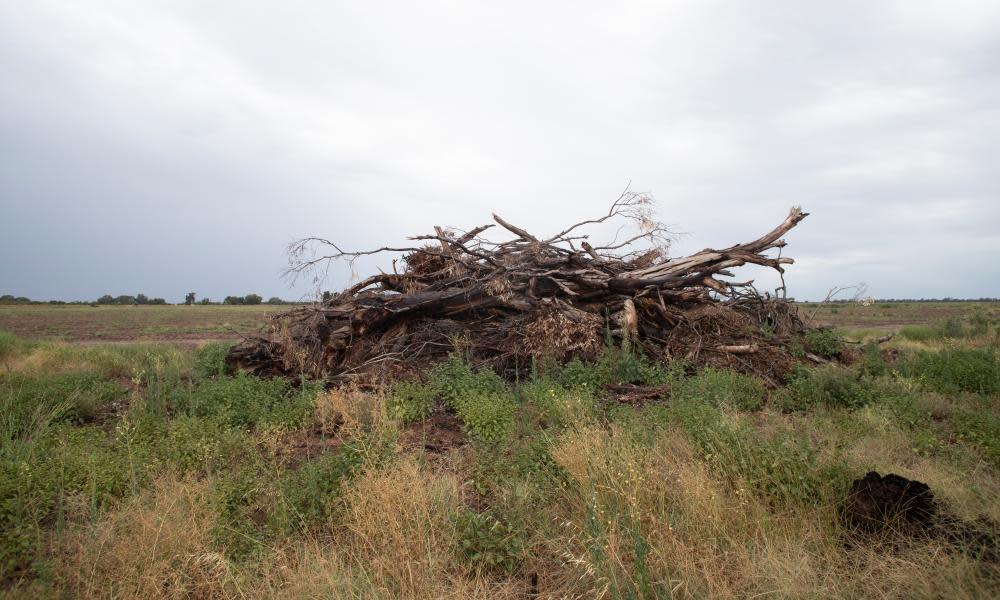Emissions warning: calls to stop ‘skyrocketing’ land clearing in NSW

Land clearing in NSW continues to exceed the long-term average, with more than 50,000 hectares of vegetation cleared for farming, forestry and infrastructure in 2020.
The NSW opposition has described the situation as unsustainable. The shadow minister for the environment, Penny Sharpe, promised Labor would use a statutory review of native vegetation laws to consider what would be necessary to stop “skyrocketing” clearing, if elected in March.
Justin Field, an independent member of the legislative council, warned the Perrottet government’s failure to bring land clearing under control threatened the state’s pledge to cut greenhouse gas emissions by 50% by 2030 and to net zero by 2050.
The data, published Thursday, shows 51,400 hectares of woody vegetation was cleared across the state in 2020, a decrease on the previous year when 54,500 hectares was cleared.
The amount of habitat destruction remains well above the 2009-17 average of 38,800 hectares, and the rate of clearing has climbed since the state government relaxed native vegetation laws in 2017.
Clearing of woody vegetation for forestry – much of this in plantations – or infrastructure increased in 2020, but there was a decrease in the rate of vegetation loss due to agricultural activity, from 23,400 hectares in 2019 to 13,000 hectares in 2020.
Related: Harsher anti-protest laws targeting environmentalists are putting greed before green | Bob Brown
The amount of non-woody vegetation such as grasslands cleared on regulated rural land was 47,200 hectares. Factoring in woody vegetation cleared in those areas, the amount reached 68,200 hectares.
Of this clearing, 75% was considered unexplained, meaning it either did not require a permit or was unlawful.
Sharpe said the opposition believed the amount of clearing was too high and criticised the government for not undertaking a promised review of land-clearing codes three years after it relaxed the rules.
A statutory review of native vegetation laws is also due.
Sharpe said if Labor won the March election it would use this review to consider what needed to change, including whether regulations should be tightened.
“Labor believes that this situation is unsustainable and needs to be addressed. Ever since the laws were changed, clearing has continued to skyrocket,” she said.
“Labor will use the statutory review to completely look at the changes that need to be made to bring land clearing to sustainable levels.”
Field said land use change was a major source of carbon emissions, but the government had been silent on how it would reverse trends in land clearing and deforestation.
He said the amount of clearing that had been classified as unexplained raised serious questions about the adequacy of monitoring and enforcement of the state’s land clearing and biodiversity protection laws.
“The National party, enabled by a disinterested Liberal party, is turning our state into a dust bowl, ignoring consistent warnings that land clearing rates are too high and a threat to biodiversity,” he said.
“There is little point throwing hundreds of millions at the land sector for natural capital and carbon sequestration when nothing is being done about the thousands of hectares of potentially illegal land clearing.”
The NSW Greens environment spokesperson, Sue Higginson, said the government should investigate the unexplained clearing to determine the cause.
“The total loss of vegetation on agricultural lands since the reforms is shocking,” she said.
Related: Australia’s climate data to UN questioned as study finds land clearing in Queensland underreported
“Although there has been a reduction in 2020, the total lost since the reforms still adds up to a significant portion of the total land.”
Chris Gambian, the chief executive of the Nature Conservation Council of NSW, said clearing had remained at “dangerously high levels” since the laws were changed.
He said more than 1,040 plants and animals in NSW were considered threatened with extinction, about 40 more than when the changes were introduced.
“The Coalition promised its new laws would enhance protections for bushland and wildlife,” he said. “These figures, and the rising number of threatened species, shows the laws completely fail to deliver on that promise.”
A spokesperson for the NSW planning and environment department said the department had a program to monitor compliance with the laws, which were “developed to ensure a balanced approach to rural land management and biodiversity conservation”.
They said in the 2020-21 financial year the department had taken action on 273 occasions, including by issuing warning letters, fines and in five cases commencing prosecution.
“The land management framework will be subject to a statutory five year review which is due to commence shortly and will report by August 2023,” the spokesperson said.
Comment has been sought from the NSW environment minister, James Griffin.

 Yahoo Movies
Yahoo Movies 
